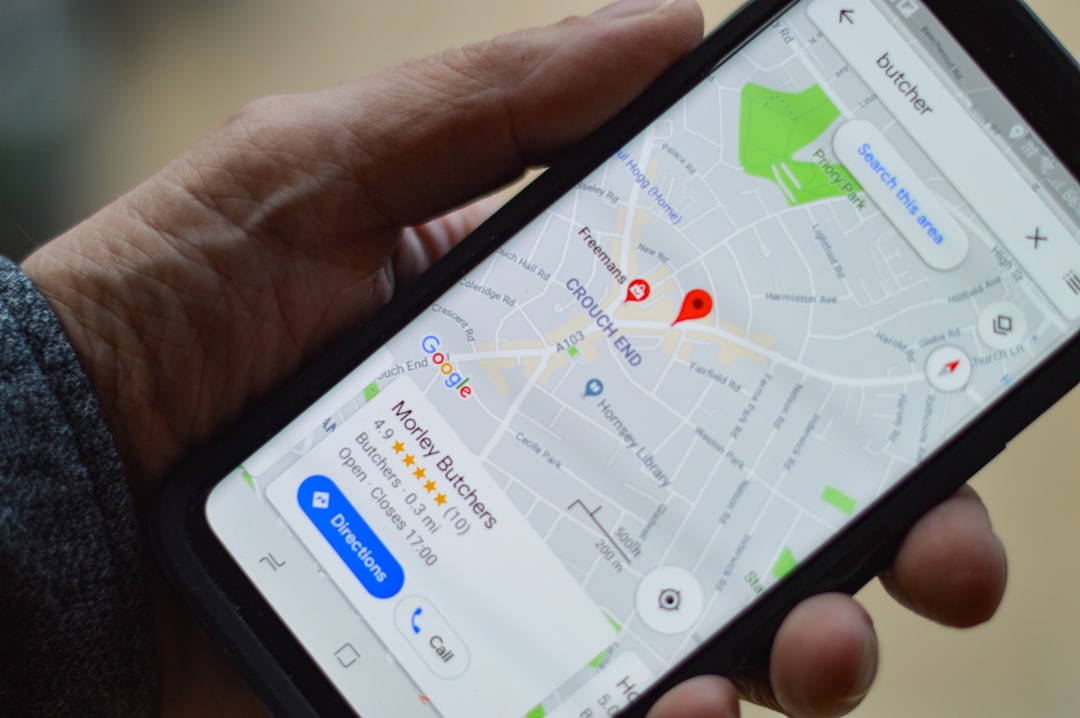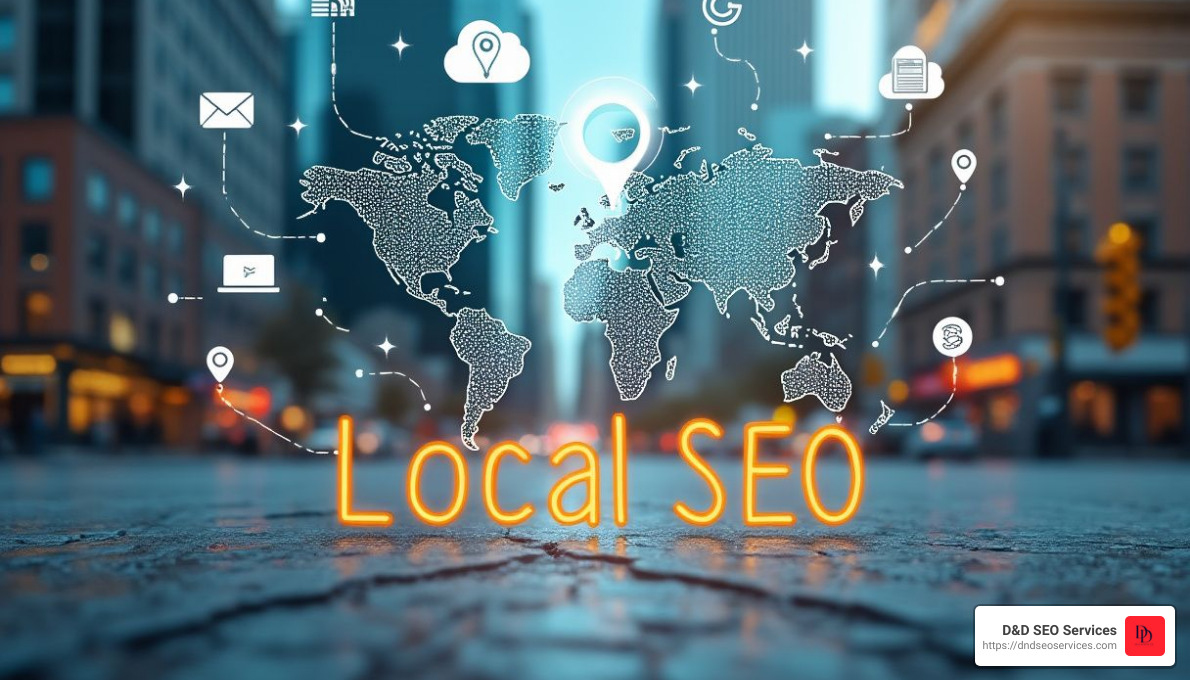Why On-Page SEO Matters for Local Businesses
Why on page SEO matters for local businesses can be summed up simply: It increases visibility, drives traffic, and boosts revenue. Here’s a quick breakdown:
- Increases Visibility: Optimizing your web pages helps your business appear in local search results.
- Drives Foot Traffic: Local searchers often have high intent to visit and make a purchase.
- Boosts Revenue: More visibility and traffic lead to more customers and sales.
On-page SEO is essential for local businesses because it meets searchers where they are—looking for nearby products or services. When potential customers search for businesses like yours, they are usually ready to buy. That’s the power of user intent: they know what they want and are looking for the best option.
Optimizing your web pages with local keywords, helpful content, and accurate business information like your name, address, and phone number (NAP) can make you stand out in search results.
I’m Danielle Birriel, an expert in SEO and digital marketing. With years of experience in on-page SEO and a background in data analysis, I understand why on page SEO matters for local businesses and how crucial it is for growth. My goal is to help you optimize your online presence and drive more customers to your business.
Let’s dive deeper into how on-page SEO can grow your local business!
What is On-Page SEO?
On-page SEO is the practice of optimizing individual web pages to rank higher and earn more relevant traffic from search engines. It involves tweaking various elements on a webpage to align with search engine algorithms and user expectations. Here are the key components:
Meta Titles and Descriptions
Meta titles and meta descriptions are concise snippets that provide a brief overview of a webpage’s content. They play a crucial role in influencing click-through rates from search engine results pages (SERPs).
- Meta Titles: These should be compelling and keyword-rich to attract relevant organic traffic.
- Meta Descriptions: Craft these to be both informative and enticing, incorporating relevant keywords naturally.
Header Tags and Content Structure
Search engines prioritize well-organized and easily readable content. Header tags (H1, H2, H3, etc.) contribute to the hierarchical structure of a page, signaling the importance of different sections.
- Header Tags: Use H1 for the main title, and H2, H3 for subheadings to make your content more scannable.
- Content Structure: Well-structured content helps search engines understand the page’s context and enhances user experience.
Keyword Optimization
Keywords are at the heart of all SEO. Integrate relevant keywords naturally within your content, including headings, body text, meta data, and links.
- Avoid Keyword Stuffing: Overuse of keywords can lead to penalization by search engines.
- Natural Integration: Ensure that keywords fit naturally within the content.
URL Structure and Internal Linking
An organized URL structure contributes to both user experience and search engine crawlers’ understanding of a page’s content.
- URL Structure: Keep URLs short, descriptive, and keyword-rich.
- Internal Linking: Use internal links to connect different pages of your website, helping users navigate and search engines understand your site’s structure.
Page Load Speed and Mobile Friendliness
User experience is paramount for search engines. Pages with faster load times tend to rank higher because they provide a smoother experience for visitors.
- Page Load Speed: Optimize images, use browser caching, and minimize code to ensure your site loads quickly.
- Mobile Friendliness: Ensure your site is responsive and adjusts to different screen sizes. Google prioritizes mobile-friendly websites due to the dominance of mobile search.
Key Components Recap
| Component | Description |
|---|---|
| Meta Titles | Compelling, keyword-rich titles to attract organic traffic |
| Meta Descriptions | Informative and enticing snippets with relevant keywords |
| Header Tags | Hierarchical structure for better readability and context |
| Keyword Optimization | Natural integration of relevant keywords |
| URL Structure | Short, descriptive, and keyword-rich URLs |
| Internal Linking | Connects different pages for better navigation and SEO |
| Page Load Speed | Fast-loading pages improve user experience and rankings |
| Mobile Friendliness | Responsive design for better mobile user experience and higher rankings |
Understanding these components and implementing them effectively can significantly enhance your local SEO efforts. Next, we’ll explore why on-page SEO matters for local businesses and how it can drive growth.
Why On-Page SEO Matters for Local Businesses
On-page SEO is crucial for local businesses aiming to stand out in search results and attract nearby customers. Let’s dive into why on-page SEO matters for local businesses.
Enhancing Local Search Visibility
Geo-Specific Keywords
Using geo-specific keywords helps search engines understand where your business operates. For example, a plumber in Vancouver should use keywords like “Vancouver plumber” or “plumbing services in Vancouver.” This signals to search engines that your business is relevant to local users.
NAP Citations
Consistency in your Name, Address, and Phone Number (NAP) across your website and other online listings is vital. Inconsistent NAP information can confuse search engines and hurt your local rankings. Ensure your NAP is prominently displayed on your site, such as in the footer.
Localized Content
Creating content tailored to your local audience builds trust and authority. Write blog posts about local events, news, or tips relevant to your community. This localized content can help you connect with your audience and improve your local search visibility.
Local Landing Pages
If your business serves multiple areas, create dedicated landing pages for each location. These pages should include local keywords and specific information about the services you offer in each area. This helps search engines match your business with local search queries.
Improving User Experience
Mobile-Friendly Design
With 88% of people searching for local businesses on mobile devices, having a mobile-friendly site is non-negotiable. A responsive design ensures your site looks and works great on all devices, improving user experience and reducing bounce rates.
Page Load Speed
Fast page load times are critical. Slow-loading pages can frustrate users and lead to higher bounce rates. Use tools like Google PageSpeed Insights to identify and fix issues slowing down your site.
Structured Data Markup
Structured data markup, like Schema Markup, helps search engines understand your content better. For local businesses, this can include information like business hours, address, and customer reviews. This can enhance your visibility in search results and even get you featured in rich snippets.
Core Web Vitals
Core Web Vitals are a set of metrics that measure user experience on your site. These include loading performance, interactivity, and visual stability. Improving these metrics can enhance user satisfaction and boost your search rankings.
Proximity Factor
Search engines consider the proximity of the searcher to the business. Ensuring your location information is accurate and up-to-date helps search engines provide the most relevant local results.
Mobile Search Trends
Mobile searches often have local intent, such as “coffee shops near me.” Optimizing your site for mobile search trends can capture this traffic. Voice search is also growing, with 58% of consumers using voice search to find local businesses. Optimize your content for voice search by using natural language and answering common questions.
By focusing on these on-page SEO elements, local businesses can improve their search visibility and attract more customers. Next, we’ll look at the key on-page SEO elements that local businesses should focus on to drive growth.
Key On-Page SEO Elements for Local Businesses
Meta Titles and Descriptions
Meta titles and meta descriptions are the first things users see on search engine results pages (SERPs). They play a major role in click-through rates. A well-crafted meta title should be keyword-rich and compelling. For example, “Best Coffee Shop in Miami – Fresh Brews Daily” grabs attention and includes the keyword “coffee shop in Miami.”
Meta descriptions provide a brief overview of the page. Although Google rewrites them 92% of the time, it’s still beneficial to write your own. Include relevant keywords and a call to action. For example, “Visit our Miami coffee shop for the freshest brews and cozy atmosphere. Open daily!”
Header Tags and Content Structure
Header tags (H1, H2, H3, etc.) help organize your content. They create a hierarchical structure that makes your page easier to read and understand. Search engines use these tags to determine the importance of different sections.
For instance, an H1 tag might be “Miami Coffee Shop – Fresh Brews Daily,” while H2 tags could break down into “Our Menu,” “Customer Reviews,” and “Visit Us.” This structure improves readability and enhances the user experience.
Keyword Optimization
Keywords are the foundation of SEO. They help search engines understand what your page is about. Use relevant keywords naturally throughout your content, including in headings, body text, and meta data.
Avoid keyword stuffing. Overusing keywords can lead to penalization by search engines. Instead, aim for a natural integration that flows with the content. For example, “Our Miami coffee shop offers a variety of fresh brews” is better than “Miami coffee shop Miami coffee shop fresh brews.”
URL Structure and Internal Linking
An organized URL structure helps both users and search engines. Keep URLs short, descriptive, and keyword-rich. For example, “yourwebsite.com/miami-coffee-shop” is better than “yourwebsite.com/page1.”
Internal linking connects different pages on your website. It helps users navigate and allows search engines to understand your site’s structure. Use contextual links within your content. For example, link the text “best coffee in Miami” to a page with customer reviews.
Page Load Speed and Mobile Friendliness
Page load speed is crucial. Faster load times improve user experience and search rankings. Google estimates that as load speed goes from one to three seconds, the probability of a visitor bouncing grows by 23%.
Mobile-first indexing means Google uses the mobile version of your site for indexing and ranking. Ensure your site has a responsive design that works well on all devices.
For a mobile-friendly site:
– Avoid unnecessary pop-ups.
– Use large buttons for easy clicking.
– Compress images to reduce load times.
– Ensure your design is responsive.
By focusing on these key on-page SEO elements, local businesses can improve their search visibility and attract more customers. Next, we’ll explore how on-page SEO affects local SEO and what steps you can take to optimize for local search.
How On-Page SEO Affects Local SEO
Locally-Targeted Keywords
Using geo-specific keywords is essential for local businesses. Imagine you’re a plumber in Vancouver. Instead of just using “plumber,” you should incorporate terms like “Vancouver plumber” or “plumbing services in Vancouver.” This helps search engines understand your business is relevant to users in that area.
By including these local keywords in your meta titles, descriptions, and content, you send strong search engine signals about your location and services. This can improve your local rankings and make it easier for potential customers to find you.
NAP Citations
Consistency in your Name, Address, and Phone Number (NAP) across all platforms is crucial for local SEO. If your NAP is inconsistent, search engines might get confused and rank you lower. Ensure that your NAP is the same on your website, Google Business Profile, and other local directories.
Trust is built when users see the same information everywhere. It also helps search engines verify your business details, improving your local search rankings. Display your NAP prominently on your website, preferably in the header, footer, and contact page.
Localized Content
Creating localized content is another way to boost your local SEO. This could involve writing blog posts about local events, creating landing pages for each service area, or even showcasing local customer reviews.
For example, if you serve multiple locations, have a dedicated local landing page for each area. These pages should include local keywords and relevant information specific to that location. This helps search engines understand the geographic areas you serve, improving your visibility in local search results.
Additionally, using local business schema markup can further enhance your local SEO. Schema markup is code that helps search engines understand your content better. For local businesses, it can display important information like your business hours, address, and customer reviews directly in search results.
By focusing on these aspects of on-page SEO, you can significantly improve your local search rankings, making it easier for customers to find and trust your business.
Next, we’ll dive into the key on-page SEO elements that every local business should focus on.
Frequently Asked Questions about On-Page SEO for Local Businesses
Why is on-page SEO important for local businesses?
On-page SEO is crucial for local businesses because it directly impacts your visibility in local search results. When someone searches for a product or service “near me,” search engines prioritize websites that are optimized for local search.
Here are key reasons why on-page SEO matters:
- Local Search Visibility: Optimizing with geo-specific keywords helps your business show up in local searches. For example, using phrases like “best bakery in Naples” can attract more local customers.
- User Intent: Local searchers often have high commercial intent. Google found that searches for “open now near me” grew by over 400% year over year. This means people are ready to visit and buy from local businesses.
- Mobile Search Trends: With 76% of people who search on smartphones visiting businesses within a day, having a mobile-friendly site is non-negotiable.
How does on-page SEO improve local search rankings?
On-page SEO improves local search rankings by making your website more relevant and accessible to both search engines and users. Here’s how:
- Localized Content: Creating content that speaks to your local audience signals to search engines that your site is relevant to local queries. For instance, a plumber in Miami should write about local plumbing issues.
- NAP Citations: Consistent Name, Address, and Phone number (NAP) information across your site and other online listings help search engines verify your business location, boosting your local ranking.
- Structured Data Markup: Using schema markup can help search engines understand your business details, like hours and reviews, which can improve your chances of appearing in local search results.
What are the best practices for on-page SEO in local SEO?
To get the most out of on-page SEO for local businesses, follow these best practices:
- Optimize Meta Titles and Descriptions: Include local keywords in your meta titles and descriptions to improve click-through rates and local search visibility.
- Use Header Tags and Content Structure: Organize your content with header tags (H1, H2, etc.) to enhance readability and user experience.
- Keyword Optimization: Integrate relevant local keywords naturally into your content. Avoid keyword stuffing as it can harm your rankings.
- Improve URL Structure and Internal Linking: Use clean, descriptive URLs and create internal links to help search engines and users navigate your site.
- Enhance Page Load Speed and Mobile Friendliness: Ensure your site loads quickly and is mobile-friendly. Google prioritizes sites that offer a positive user experience, especially on mobile devices.
By implementing these practices, you can improve your local search rankings and attract more local customers.
Next, we’ll explore how on-page SEO directly affects local SEO and the specific elements you should focus on.
Conclusion
In summary, on-page SEO is crucial for local businesses aiming to grow their local market presence. By optimizing your website for local search visibility and improving user experience, you can attract more local customers and increase your revenue.
On-page SEO helps your business appear in local search results, which is vital given that 97% of users search online to find local businesses. This visibility brings in potential customers who are ready to take action, whether it’s visiting your store or making a purchase online.
At D&D SEO Services, we understand the unique challenges local businesses face. Our personalized strategies focus on optimizing your website for local search, ensuring your business stands out in your community.
By incorporating geo-specific keywords, ensuring NAP consistency, creating localized content, and optimizing for mobile devices, we help you rank higher in local searches. This targeted approach not only boosts your search engine rankings but also enhances your overall user experience, leading to higher conversion rates.
Local market growth is achievable with the right on-page SEO techniques. By partnering with us, you’ll gain access to expert knowledge and proven strategies tailored to your business needs.
Ready to take your local SEO to the next level? Contact D&D SEO Services today for a personalized website optimization plan.
By focusing on on-page SEO, you can drive more local traffic and convert visitors into loyal customers. Let’s work together to make your business a local customer magnet.








